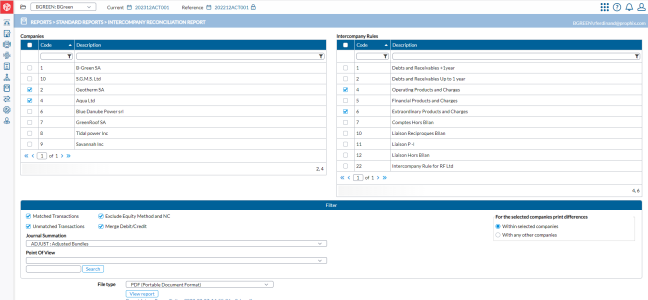Intercompany reconciliation report
The Intercompany Reconciliation report is designed to identify unmatched intercompany transactions, which refers to paired transactions that have inconsistencies in terms of amounts, currencies, or those that have not been matched with their corresponding transactions. By running this report, you can effectively address any discrepancies found in sales and billing information between intercompany partners.
Note: We recommend that you run this report as part of your period end process to help identify any problems related to intercompany transactions before running elimination for the period.
To access the Intercompany Reconciliation Report page, click  Reports > Standard Reports > Intercompany Reconciliation report.
Reports > Standard Reports > Intercompany Reconciliation report.
Generate an intercompany reconciliation report
Intercompany transactions are transactions between two companies. Each intercompany account must be linked to an intercompany rule.
-
In the Companies table, select the companies.
-
In the Intercompany rules table, select the rule /rules to run on the report.
-
In the Filter section, you have options to specify:
-
the type of transactions to include on the report. You can select Matched Transactions or Unmatched Transactions, or both.
-
whether to Exclude Equity Method and Non-Cash (NC) transactions.
-
whether to Merge Debit/Credit transactions on the report. If this option is not selected, debit /credit transactions will be listed in separate columns.
-
In the For the selected companies print differences panel, choose how you want differences to be printed:
-
 - if you select two companies, only the intercompany transactions between the two selected companies will be taken into account in the report. For example, if you select company A and company B, only the transactions against A and B, and B against A will be included in the report.
- if you select two companies, only the intercompany transactions between the two selected companies will be taken into account in the report. For example, if you select company A and company B, only the transactions against A and B, and B against A will be included in the report.
-
 - if you select two companies, the report will contain the intercompany transactions between the two selected companies against any other companies of the group but not the transactions between other companies that the two selected companies are not a part of. For example, if you select company A and company B, transactions by A against any other company and any against A, plus transactions by B against any other company and any against B will be included in the report.
- if you select two companies, the report will contain the intercompany transactions between the two selected companies against any other companies of the group but not the transactions between other companies that the two selected companies are not a part of. For example, if you select company A and company B, transactions by A against any other company and any against A, plus transactions by B against any other company and any against B will be included in the report.
-
-
-
From the Journal Summation drop-down list, choose an option to specify how you want the accounting codes and ledger entries organized on the report.
-
To include a Point of View, click
 to search for, and select one.
to search for, and select one. -
In the File type field, select the output file type. Options include PDF, XLS, and XLSX.
-
Click
 to generate the report. After the report is generated, a download link appears below for you to click and view it in the file type selected.
to generate the report. After the report is generated, a download link appears below for you to click and view it in the file type selected.
